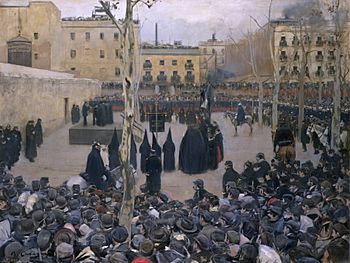Garrote vil (Garrotte) facts for kids
Quick facts for kids Garrote vil (Garrotte) |
|
|---|---|
 |
|
| Artist | Ramon Casas |
| Year | 1894 |
| Medium | Oil on canvas |
| Dimensions | 127 cm × 162.5 cm (50 in × 64.0 in) |
| Location | Museo Nacional Centro de Arte Reina Sofía, Madrid |
Garrote vil (Garrotte) is a famous painting from 1894 by the artist Ramon Casas. He created it in Barcelona, and today you can see it at the Museo Nacional Centro de Arte Reina Sofía in Madrid, Spain.
The painting was first shown to the public in 1895 at the National Exhibition of Fine Arts. It won third prize there. Because it won, the Spanish government bought it for a museum called the Museo de Arte Moderno. Later, in 1971, it moved to the Prado Museum. Finally, in 1995, it found its current home at the Museo Nacional Centro de Arte Reina Sofía.
About the Painting
Ramon Casas was a well-known artist. Around 1893 and 1894, he often painted portraits and scenes inside homes with women. However, this painting shows a different side of his work.
A Glimpse of Barcelona Life
Casas used this painting to show a moment in the city of Barcelona. He captured a large crowd of people watching a serious public event. The artist wanted to show what was happening in the city at that time. He painted the scene very realistically, almost like a photograph. He didn't try to make a strong social statement. Instead, he just showed the situation as it was.
This painting was the start of a new style for Casas. He began to create paintings that were like "social chronicles." These works showed everyday life and important events. He moved away from dramatic historical paintings.
The Artist's Viewpoint
Casas chose to paint the scene from a high viewpoint. This makes it feel like you are looking down on the event. He included small details, like a tree in the foreground. This tree partly blocks the view, making it feel more real, as if you are an eyewitness.
The artist wanted to show the public event as it happened. He didn't focus on one main person, not even the prisoner. The prisoner is hard to see, hidden between the person carrying out the punishment and the priests. Casas wanted viewers to look around the painting as if they were really there. You can also see members of the Confraternity of the Blood of Christ. They are wearing their special pointed hoods.
See also
 In Spanish: El garrote vil para niños
In Spanish: El garrote vil para niños

